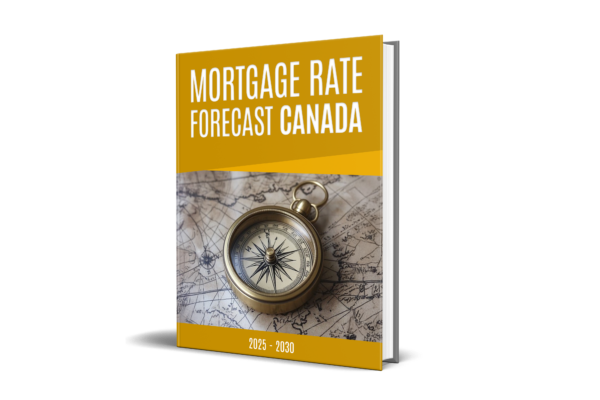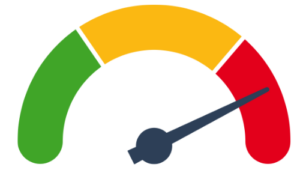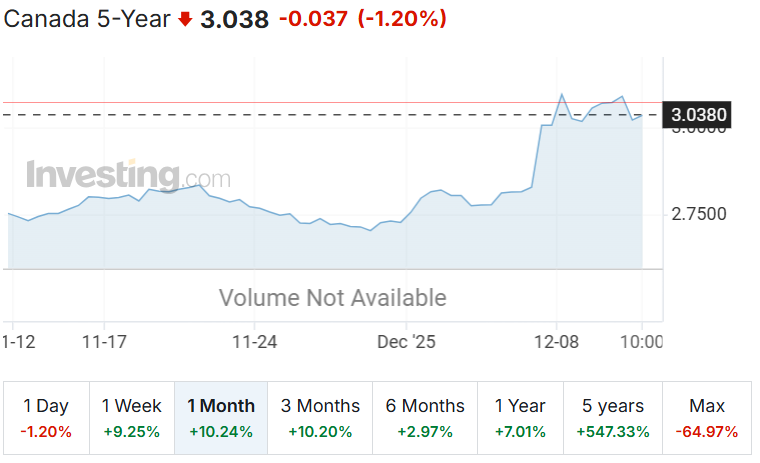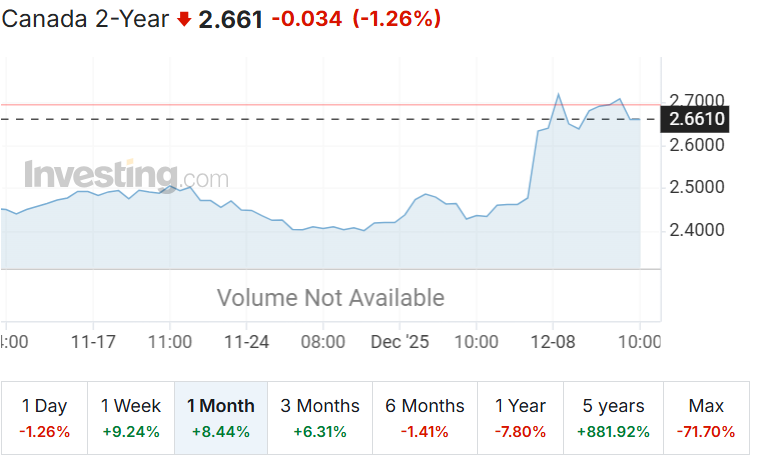Mortgage Rate Forecast Canada 2025–2030 (Updated Weekly)
By Brent Richardson, Mortgage Broker & Certified Financial Planner (CFP®)
The decisions Canadians make on their mortgage in 2025/2026 largely depend on the mortgage rate forecast. It’s a decision that will affect homeowners for several years to come and could save thousands of dollars in mortgage interest.
Here we’ll look at where mortgage rates are likely headed, based on a review of real time economic insights, and years of in-depth, ‘ground level’ mortgage market study, with over 1,900 mortgages personally closed.
You’ll learn how to position yourself for the best possible mortgage rate – and turn it into real savings over the next five years.
Page Last Updated: December 10, 2025

Key Mortgage Rate Forecast Takeaways
- On Dec 10, the Bank of Canada held its overnight rate at 2.25%, which is the low end of the neutral range of 2.25%-3.25%.
- The Next BoC meeting is on January 28, 2025, with a 94% chance of a hold.
- Financial markets are currently forecasting the next Bank of Canada move will be a 0.25% hike in Fall 2026.
- A total of 3 Bank of Canada hikes are projected over the next 3 years.
- Core inflation for October, released Nov 17, remains sticky at 3%, keeping a floor on further BoC cuts.
- A stronger than expected November Jobs report brought the unemployment rate down to 6.5%, sending Government of Canada Bond Yields and fixed mortgage rate pressure sharply higher.
- Adding to already higher Bond Yields over the past month, fixed mortgage rates have started increasing in the 0.10 – 0.20% range.
- Variable mortgage rates are now 0.30%–0.50% lower than most 5-year fixed options.
- Stalling US trade negotiations on one side and a stimulative $78.3B federal budget deficit and stabilizing jobs market on the other side, create a tug-of-war between weak growth and inflation concerns.
- Given high market volatility, much could change over the next year.
What’s New This Week
- Bank of Canada Holds its overnight rate at 2.25% — with only 3% odds of a cut going into this weeks meeting, it didn’t come as a surprise that the Bank of Canada decided to hold. However what is surprising to many, is that there is currently more upward pressure on the Bank of Canada than downward pressure. Financial markets currently project an 84% chance of hike by December 2026, given the current trajectory of the Canadian economy.
- The November Jobs report blew past analyst expectations adding 54,000 jobs and bringing the unemployment rate down to 6.5%. This caused Bond Yields to move sharply higher, which is in the process of sending fixed mortgage rates 0.10 – 0.20% higher too. It should be noted that the added jobs were all part time, and seasonal work is likely a factor. Overall though, the recent 3 jobs reports point to a stabilizing Canadian jobs market, not a weakening one.
- Bond yields are up ~ 25 basis points to ~3.03%; this has begun to push fixed rates higher.
We’re watching: Monday December 15, CPI/ Inflation report
Fixed Mortgage Rate Pressure

Interest Rate Canada Outlook: Market Odds
Chances of a Bank of Canada interest rate cut (based on Bond Yield and OIS market odds):
| Meeting | Cut Probability | BoC Rate (After Cut) |
| Jan 28, 2026 | 6% | 2.00 % if cut |
| Mar 18. 2026 | 5.5% | 2.00 % if cut |
| April 29, 2026 | 5% | 2.00% % if cut |
Next Bank of Canada Rate Move:
Pause for 2026. Markets currently price just a 1% chance for a BoC overnight rate cut in all of 2026. Markets are also forecasting an 84% chance of a hike by December 2026. This is based on all known political and economic data, but this can change, as we saw earlier in 2025.
Big Bank Rate Forecasts
| Bank | Year-End 2025 BoC Rate | Year-End 2026 Rate |
| RBC | 2.25 % | 2.25 % |
| TD | 2.25 % | 2.25 % |
| Scotiabank | 2.25 % | 2.75 % |
| BMO | 2.25 % | 2.00 % |
| CIBC | 2.25 % | 2.25 % |
Current Data Driving This Rate Forecast
Here is the most important data that is factored into these interest rate forecasts. Taken together, the data form an economic forecast that the Bank of Canada is likely to base its interest rate decision.
Financial markets use this data, along with updates from the BoC itself, to predict how the BoC will act.
The data are arranged from ‘highest level’ or broadest to most specific, generally reflecting the flow of ‘economic cause and effect’, and how it’s distilled into Government of Canada bond yields and interest rate probability/odds.
Federal Government Policy and Global Trade Developments
The legality of US tariffs are on the line at the US Supreme Court, with betting markets showing just a 24% chance that the courts will uphold the tariffs.
However, the Presidential office is pushing back, saying they will need to repay hundreds of billions in tariff levies if tariffs are cut and this will set the US back.
The outcome of this Court Ruling will have significant consequences for global trade, Canadian growth, and mortgage interest rate projections.
Economic Growth/ GDP:
GDP expanded by 0.6% in Q3 2025 (2.6 % annualized) vs 0.05% expected growth. However, it was primarily Government spending behind this growth, as consumer and business spending stalled. Early data for October 2026 (Q4) points towards economic contraction.
Employment:
Employment shows signs of stabilizing. In November, Canada added 55,000 jobs. This on the heels of 67,000 new jobs in October. The unemployment rate dipped to 6.5%, indicating labour market stability—enough to keep the BoC on the sidelines for now.
Inflation:
Core inflation remains stubbornly close to 3%, despite falling fuel prices. Shelter, auto insurance, call phone prices, and food inflation are the main culprits. Until core inflation dips below 2.75 %, expect limited BoC easing. Stabilizing employment may not lead to lower inflation in the short term, as the BoC and economists had been expecting.
BoC Policy statements:
To summarize current BoC communication as of their most recent press release:
- They are satisfied with the level of the overnight interest rate.
- The BoC is factoring in sustained softness in economic growth and employment, with rates at current levels.
- An economic or trade crisis would cause the BoC to reevaluate the current 2.25% rate (and likely cut it further). However, this is currently a ‘wait and see’ situation.
5 YR Government of Canada Bond Yield:
The 5 YR government of Canada bond yield is highly correlated and predictive of 5 year fixed mortgage rates. When we see this yield drop substantially, expect 5 year fixed rates to fall. But it’s the opposite when yields are rising – expect upward pressure on fixed mortgage rates.
Currently, the 5 year bond yield is seeing substantial upward pressure. Accordingly we are seeing fixed mortgage rates increase 0.10% – 0.20%. If the Canadian economy weakens in early 2026, we’ll see yields and fixed rates soften. However if the economy continues to stabilize we will see yields and fixed rates firm up.

2 YR Government of Canada Bond Yield
The 2 year government of Canada bond yield is generally a good predictor for where the Bank of Canada overnight rate will be within 2 years.
The current 2 year yield of ~2.66% indicates upward pressure on the BoC overnight rate over the next 2 years. More specifically, according to this chart, we are likely to see a 0.25% increase in the BoC overnight rate from 2.25% to 2.5% within 2 years.

4 YR Rate Swap: 2.78% – Up 0.18% on the week.
A derivative of bond yields or a ‘synthetic financial instrument’; its predictive power over fixed mortgage rates is very accurate. Think of this data measure as a financial ‘betting market’ for where bond yields and fixed mortgage rates will be.
The current 4 year swap is 2.78% and when used in combination with 5-year bond yields, indicates upward fixed mortgage rate pressure in the near term.
Medium-Term Mortgage Rate Forecast (2025–2030)
| Year | BoC Overnight Rate (Est.) | 5-Year Fixed Avg | Variable (Bank Prime -0.75%) | Inflation (Avg) |
| 2025 | 2.25% | 3.8 – 4.2% | 3.7 % | 3.0 % |
| 2026 | 2.25 – 2.50% | 4.0 – 4.4% | 3.7 – 3.95% | 2.75 % |
| 2027 | 2.50 – 2.50% | 4.5 % | 3.95% | 2.75 % |
| 2028 | 2.50 – 2.75% | 4.6% | 3.95 – 4.2% | 2.75 % |
| 2029-2030 | 2.75% | 4.7% | 4.2% | 2.75 % |
Overall, we project a gentle normalization of interest rates: higher than the ultra-low 2010s, but not restrictive. Expect mortgage rates to range from 3–5% as the new normal over the next 5 years.
Weekly Fireside Rate Chat with Brent Richardson (Article Author, Mortgage Broker)
Short Commentary on Video:
“Inflation still runs hotter than markets expected, and that’s the bigger risk than a US trade slowdown. Unless we see a major global shock or a sharp rise in unemployment, rates are unlikely to fall much further. This is especially supported by recent strength in jobs numbers. It’s a time to manage risk, not chase the absolute lowest rate.”
How This Rate Forecast Applies to Your Mortgage
Let’s translate the macroeconomic picture into real world mortgage decision strategy.
Fixed vs Variable
Variable rates have likely hit a bottom, based on current market data and Bank of Canada commentary that they are ‘satisfied with where rates are’.
More specifically, the BoC is counting on further economic softness in Canada and on inflation dropping from here. So further declines in these areas will not impact near term BoC decisions.
With that said, data can change quickly, and if there is a crisis, such as a longer term breakdown in trade relations with the US or a banking crisis, this could send BoC rates spiralling down and variable mortgage rates along with them.
At this point, this kind of crisis situation is highly speculative and is not substantially reflected in the market data. In other words, selecting a variable at this point would be a ‘bet’ that the market is wrong, and that rates will continue to fall.
Along these lines, fixed mortgage rates have levelled off for now and are likely at their short- to medium-term bottom—again, barring some sort of significant economic disruption.
Inflation is currently a greater threat to pushing up interest rates than a trade or banking crisis is to bringing them down. In fact, financial markets are calling for rate increases in 2027 through 2029, so based on this data and perspective, it may be prudent to consider a 5-year fixed rate term.
See Our Full Fixed Vs Variable Rate article HERE
Mortgage Renewals
Renewing your mortgage in 2025 or 2026? Expect the most discounted fixed rate specials to in the 3.69% – 4.1 % range, with variable in the 3.60 – 3.90% range.
Consider renewing early if youre coming off a higher rate (ex. a 2-3 year fixed rate above 5%), and either has a relatively low 3 month interest breakage penalty, or NO penalty given close proximity to the renewal date.
If a lender offers a rate under 4%; the net savings over 5 years can realistically be $1,000 – $3,000 on a $500 K mortgage.
Consider a rate hold of up to 4 months. Although the current lender won’t likely hold the rate, approach a mortgage broker such as Altrua Financial to protect your rate against upside while leaving the opportunity to reduce it if rates drop. There is no financial cost, and only a benefit to this renewal rate strategy.
Home Buyers
Affordability improves slightly as rates ease, but stress-test levels remain higher at 2% over the contract rate you’ve been quoted.
Given this, the variable rates in the 3.60% range will result in the highest pre approvals, with the stress test rate in the 5.6% range. However, not by much—likely just a few thousand in higher pre approval over a fixed rate in the 3.79%-3.99% range.
The most important factor in your home-buying mortgage rate is payment affordability relative to other goals. Here are some essential questions:
Will you have the flexibility to pursue other life interests and goals?
Do you plan on having your mortgage paid off before or by retirement?
Are you saving enough for retirement while also paying your mortgage?
Would an increase in the rate during the term affect these goals? Or is there sufficient cash flow in your household to withstand a payment increase?
Investors
For those with a higher risk tolerance, leveraged investing is attractive with a high 3/ low 4% borrowing cost.
Given forecasts of higher inflation, this may put upward pressure on equity and other asset markets.
At the same time, higher inflation is likely to push up rates in the medium- to long-term.
But for the time being, interest rates remain close to inflation—slightly higher, potentially a time to lock in for a longer period, such as 5 years—focusing on the delta of higher asset growth than a rate of ~4%.
On the other hand, a variable rate could act as a hedge against an economic crisis. If the economy were to plunge and take asset prices with it, at least your mortgage interest costs would fall too. Although this scenario isn’t priced into markets currently, it does not rule out consideration of this strategy.
How Interest Rates are Influencing Canada’s Housing Market
- Falling rates typically spark demand, but not in 2025 due to buyer hesitation from trade and general economic uncertainty.
- National prices are flat (+0.3 % y/y), while new listings have climbed 15%, improving buyer market conditions.
- Regional split: GTA and GVA remain soft, with slightly lower month-over-month values; the Prairies show resilience.
Expect continued softness into the winter of 2026, and when trade and economic prospects stabilize (even if at a slower growth rate) a steady, data-driven recovery, not a boom, driven by attracting mortgage rates and better affordability.
FAQ
Q: Will mortgage rates drop further in 2026?
A: Possible, but only if core inflation falls below 2.5 % and unemployment rises significantly (ie 9%+ nationally). Expect a move towards stability, not sharp declines – or increases.
Q: Will we see 2% mortgage rates again?
A: Highly unlikely. Canada’s neutral rate is 2.25 – 3.25 %, drawing the 5-year fixed in the 4 – 5 % range longer term.
Q: How do tariffs and trade tensions impact rates?
A: Tariffs add short-medium term global inflation.The effect is a gradual but persistent upward pressure on interest rates.
Q: What is the best strategy for 2025 borrowers?
A: For most, a 5-year fixed near (ideally under) 4% balances stability and cost. This is a good conservative play. While confident borrowers can start with a variable and monitor lock-in points
About Brent Richardson
Mortgage Broker | Owner | Certified Financial Planner (CFP)
Brent has helped thousands of Canadians optimize their mortgage and investment strategies. With over 1,900 mortgages closed and nearly two decades of experience at the intersection of mortgages and financial planning, Brent combines real-world data and insight for clients who want clarity in a changing market.

